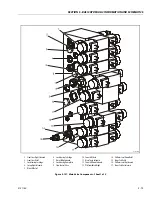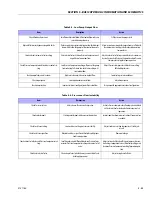
SECTION 5 - BASIC HYDRAULIC INFOR
M
ATION AND SCHE
M
ATICS
3121160
5-79
5.11
HYDRAULIC COMPONENT START-UP
PROCEDURES AND RECOMMENDATIONS
From a hydrostatic component standpoint, the goal at system
start up is to put into functional operation, the hydrostatic sys-
tem in such a way as to preserve the designed life span of the
system. The following start-up procedure should be adhered
to whenever a new pump or motor is initially installed into a
machine, or a system is restarted after either a pump or motor
has been removed and/or replaced.
THE FOLLOWING PROCEDURE MAY REQUIRE THE MACHINE TO BE DISABLED
(WHEELS RAISED OFF THE GROUND, WORK FUNCTIONS DISCONNECTED, ETC.)
WHILE PERFORMING THE PROCEDURE IN ORDER TO PREVENT INJURY. TAKE
NECESSARY SAFETY PRECAUTIONS BEFORE MOVING THE VEHICLE/MACHINE.
Prior to installing the pump and/or motor, inspect the unit(s)
for damage that may have been incurred during shipping and
handling. Make certain that all system components (reservoir,
hoses, valves, fittings, heat exchanger, etc.) are clean prior to
filling with fluid.
Fill the reservoir with recommended hydraulic fluid. This fluid
should be passed through a 10 micron (nominal, no bypass)
filter prior to entering the reservoir. The use of contaminated
fluid will cause damage to the components, which may result
in unexpected vehicle/machine movement.
NOTE:
If a pump or motor is being replaced due to internal dam-
age, the remaining units (pump or motors) need to be
inspected for damage and contamination, and the entire
hydraulic system will need to be flushed and the fluid
replaced. Failure to do so may cause considerable damage
to the entire system.
The inlet line leading from the reservoir to the pump must be
filled prior to start-up. Check the inlet line for property tight-
ened fittings and make sure it is free of restrictions and air
leaks.
NOTE:
In most cases, the reservoir is above the pump inlet so that
the pressure head created by the higher oil level helps to
keep the inlet pressures within an acceptable range and
prevent high vacuum levels. However, due to hose routing
or low reservoir locations, there may be air trapped within
this line. It is important to assure that the air is bled from
this line. This can be accomplished by loosening the hose at
the fitting closest the pump. When oil begins to flow, the
line is full, the air has been purged, and the fitting can be
retightened to its specified torque. If the tank needs to be
pressurized in order to start the flow of oil, a vacuum read-
ing should be taken at the inlet of the pump during opera-
tion in order to verify that the pump is not being asked to
draw an inlet vacuum higher than it is capable of. Be cer-
tain to fill the pump and/or motor housing with clean
hydraulic fluid prior to start up. Fill the housing by pouring
filtered oil into the upper case drain port.
NOTE:
It is highly recommended to use the highest possible case
drain port, this ensures that the housing contains as much
oil as possible and offers the greatest amount of lubrica-
tion to the internal components.
NOTE:
In initial start-up conditions, it may be convenient to fill the
housing, just prior to installing the case drain line. Compo-
nent, (especially motor), location may be such that access
to the case drain port after installation is not realistic.
NOTE:
Make certain that the oil being used to fill the component
housing is as clean as possible, and store the fill container
in such a way as to prevent it from becoming contami-
nated.
Install a 60 bar (or 1000 psi) pressure gauge in the charge pres-
sure gauge port in order to monitor the charge pressure dur-
ing start-up.
It is recommended that the external control input signal, (elec-
trical connections for EDC), be disconnected at the pump con-
trol until after initial start-up. This will ensure that the pump
remains in its neutral position.
DO NOT START THE ENGINE UNLESS PUMP IS IN THE NEUTRAL POSITION
(0 DEGREES SWASHPLATE ANGLE). TAKE PRECAUTIONS TO PREVENT MACHINE
MOVEMENT IN CASE PUMP IS ACTUATED DURING INITIAL START-UP.
"Jog" or slowly rotate the engine until charge pressure starts to
rise. Start the engine and run at the lowest possible RPM until
charge pressure has been established. Excess air should be
bled from the system lines as close to the motors as possible.
NOTE:
With the engine on low idle, "crack", (loosen-don't remove),
the system lines at the motor(s). Continue to run the engine
at low idle and tighten the system lines as soon as oil is
observed to leak from them. When oil is observed to "leak"
at the motor the line is full, the air has been purged, and
the system hoses should be retightened to their specified
torque.
Once charge pressure has been established, increase speed to
normal operating RPM. Charge pressure should be as indi-
cated in the pump model code. If charge pressure is inade-
quate, shut down and determine the cause for improper
pressure.
Summary of Contents for 740AJ
Page 2: ......
Page 55: ...SECTION 3 CHASSIS TURNTABLE 3121160 3 3 This page left blank intentionally...
Page 116: ...SECTION 3 CHASSIS TURNTABLE 3 64 3121160 Figure 3 44 Swing Hub Prior to SN 0300074383...
Page 203: ...SECTION 3 CHASSIS TURNTABLE 3121160 3 151 Figure 3 77 EFI Component Location...
Page 206: ...SECTION 3 CHASSIS TURNTABLE 3 154 3121160 Figure 3 78 ECM EPM Identification ECM EPM...
Page 224: ...SECTION 3 CHASSIS TURNTABLE 3 172 3121160 Figure 3 83 Deutz EMR 2 Troubleshooting Flow Chart...
Page 228: ...SECTION 3 CHASSIS TURNTABLE 3 176 3121160 Figure 3 87 EMR 2 Engine Plug Pin Identification...
Page 229: ...SECTION 3 CHASSIS TURNTABLE 3121160 3 177 Figure 3 88 EMR 2 Vehicle Plug Pin Identification...
Page 230: ...SECTION 3 CHASSIS TURNTABLE 3 178 3121160 Figure 3 89 EMR2 Fault Codes Sheet 1 of 5...
Page 231: ...SECTION 3 CHASSIS TURNTABLE 3121160 3 179 Figure 3 90 EMR2 Fault Codes Sheet 2 of 5...
Page 232: ...SECTION 3 CHASSIS TURNTABLE 3 180 3121160 Figure 3 91 EMR2 Fault Codes Sheet 3 of 5...
Page 233: ...SECTION 3 CHASSIS TURNTABLE 3121160 3 181 Figure 3 92 EMR2 Fault Codes Sheet 4 of 5...
Page 234: ...SECTION 3 CHASSIS TURNTABLE 3 182 3121160 Figure 3 93 EMR2 Fault Codes Sheet 5 of 5...
Page 303: ...SECTION 4 BOOM PLATFORM 3121160 4 31 Figure 4 20 Rotator Assembly HELAC...
Page 460: ...SECTION 5 BASIC HYDRAULIC INFORMATION AND SCHEMATICS 5 116 3121160 NOTES...
Page 467: ...SECTION 6 JLG CONTROL SYSTEM 3121160 6 7 Figure 6 2 ADE Block Diagram...
Page 534: ...SECTION 6 JLG CONTROL SYSTEM 6 74 3121160 NOTES...
Page 580: ...SECTION 7 BASIC ELECTRICAL INFORMATION SCHEMATICS 7 46 3121160 NOTES...
Page 581: ......









































